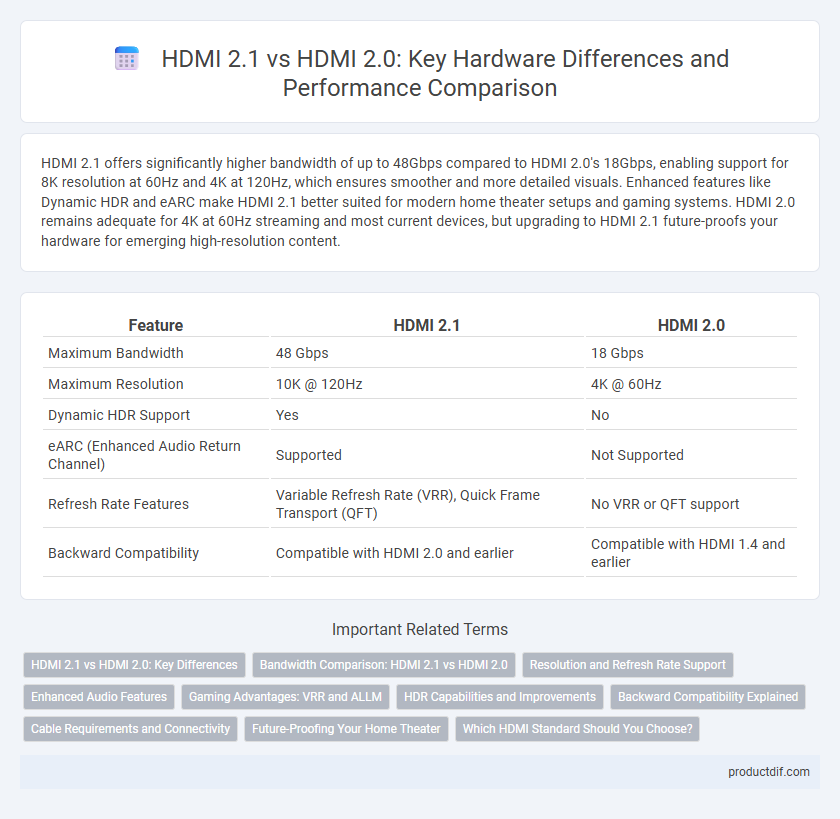HDMI 2.1 offers significantly higher bandwidth of up to 48Gbps compared to HDMI 2.0's 18Gbps, enabling support for 8K resolution at 60Hz and 4K at 120Hz, which ensures smoother and more detailed visuals. Enhanced features like Dynamic HDR and eARC make HDMI 2.1 better suited for modern home theater setups and gaming systems. HDMI 2.0 remains adequate for 4K at 60Hz streaming and most current devices, but upgrading to HDMI 2.1 future-proofs your hardware for emerging high-resolution content.
Table of Comparison
| Feature | HDMI 2.1 | HDMI 2.0 |
|---|---|---|
| Maximum Bandwidth | 48 Gbps | 18 Gbps |
| Maximum Resolution | 10K @ 120Hz | 4K @ 60Hz |
| Dynamic HDR Support | Yes | No |
| eARC (Enhanced Audio Return Channel) | Supported | Not Supported |
| Refresh Rate Features | Variable Refresh Rate (VRR), Quick Frame Transport (QFT) | No VRR or QFT support |
| Backward Compatibility | Compatible with HDMI 2.0 and earlier | Compatible with HDMI 1.4 and earlier |
HDMI 2.1 vs HDMI 2.0: Key Differences
HDMI 2.1 supports a maximum bandwidth of 48 Gbps, significantly higher than HDMI 2.0's 18 Gbps, enabling features like 8K resolution at 60Hz and 4K at 120Hz. Enhanced Audio Return Channel (eARC) in HDMI 2.1 delivers superior audio quality and simplifies connectivity compared to the ARC in HDMI 2.0. Variable Refresh Rate (VRR) and Quick Frame Transport (QFT) in HDMI 2.1 reduce latency and provide smoother gameplay, improvements not available in HDMI 2.0.
Bandwidth Comparison: HDMI 2.1 vs HDMI 2.0
HDMI 2.1 significantly increases maximum bandwidth to 48 Gbps compared to HDMI 2.0's 18 Gbps, enabling support for higher resolutions and refresh rates such as 8K at 60Hz or 4K at 120Hz. This expanded bandwidth facilitates advanced features like Dynamic HDR and eARC, which are unsupported in HDMI 2.0. Higher data transfer rates in HDMI 2.1 also improve overall signal quality and future-proof compatibility with next-gen display technologies.
Resolution and Refresh Rate Support
HDMI 2.1 significantly outperforms HDMI 2.0 by supporting resolutions up to 10K and refresh rates as high as 120Hz, while HDMI 2.0 is limited to 4K resolution at 60Hz. This advancement enables smoother motion and enhanced visual clarity, critical for gaming and high-definition video playback. Enhanced bandwidth of 48 Gbps in HDMI 2.1 compared to 18 Gbps in HDMI 2.0 allows for these superior resolution and refresh rate capabilities.
Enhanced Audio Features
HDMI 2.1 supports advanced audio formats such as eARC (enhanced Audio Return Channel), enabling higher bandwidth and lossless audio transmission including Dolby Atmos and DTS:X. HDMI 2.0 offers standard ARC with limited bandwidth, restricting audio quality and channel support. The enhanced audio features of HDMI 2.1 provide superior sound fidelity and seamless compatibility with next-generation home theater systems.
Gaming Advantages: VRR and ALLM
HDMI 2.1 enhances gaming performance with support for Variable Refresh Rate (VRR), reducing screen tearing and stuttering for smoother gameplay compared to HDMI 2.0. Auto Low Latency Mode (ALLM) automatically switches the display to low latency mode, minimizing input lag and improving responsiveness. Gamers benefit from higher bandwidth and advanced features in HDMI 2.1 that optimize visual experience on compatible 4K and 8K displays.
HDR Capabilities and Improvements
HDMI 2.1 significantly enhances HDR capabilities compared to HDMI 2.0 by supporting Dynamic HDR, which allows frame-by-frame adjustment of color, contrast, and brightness for a more lifelike visual experience. It also supports higher bandwidth up to 48 Gbps, enabling 4K at 120Hz and 8K at 60Hz with improved color depth and wider color gamuts like BT.2020. These advancements make HDMI 2.1 ideal for next-generation HDR formats such as HDR10+ and Dolby Vision, enhancing overall picture quality and dynamic range.
Backward Compatibility Explained
HDMI 2.1 maintains full backward compatibility with HDMI 2.0 and earlier versions, ensuring seamless connectivity with older devices while enabling higher bandwidth for 4K at 120Hz and 8K at 60Hz video formats. Devices supporting HDMI 2.1 feature enhanced audio return channel (eARC) and variable refresh rate (VRR), which function effectively when connected to HDMI 2.0 ports, though only at the lower HDMI 2.0 capabilities. This backward compatibility prevents the need for immediate hardware upgrades, providing users with a flexible transition to next-generation multimedia standards.
Cable Requirements and Connectivity
HDMI 2.1 requires ultra high-speed HDMI cables rated for bandwidths up to 48 Gbps, supporting resolutions up to 10K and higher refresh rates, whereas HDMI 2.0 operates on standard high-speed cables with bandwidths up to 18 Gbps, limiting resolution to 4K at 60Hz. The enhanced bandwidth in HDMI 2.1 cable specifications enables features like Dynamic HDR, eARC, and Variable Refresh Rate (VRR), which are not fully supported by HDMI 2.0 cables. Ensuring compatibility with HDMI 2.1 devices demands certified ultra high-speed cables to achieve optimal connectivity and performance.
Future-Proofing Your Home Theater
HDMI 2.1 significantly enhances future-proofing by supporting higher bandwidths up to 48 Gbps, enabling 8K resolution at 60Hz and 4K at 120Hz, compared to HDMI 2.0's 18 Gbps limit. Advanced features like Dynamic HDR, eARC, and Variable Refresh Rate (VRR) ensure compatibility with next-generation gaming consoles and AV receivers. Investing in HDMI 2.1 cables and devices guarantees seamless integration with emerging home theater technologies, preserving performance longevity and upgrade flexibility.
Which HDMI Standard Should You Choose?
HDMI 2.1 supports higher bandwidth up to 48 Gbps, enabling 8K resolution at 60Hz and 4K at 120Hz, while HDMI 2.0 maxes out at 18 Gbps, limiting it to 4K at 60Hz. For gamers and home theater enthusiasts seeking future-proofing and superior performance, HDMI 2.1 offers features like Dynamic HDR, eARC, and variable refresh rate technology. If your devices only support 4K at 60Hz and you don't use these advanced features, HDMI 2.0 remains a cost-effective choice.
HDMI 2.1 vs HDMI 2.0 Infographic

 productdif.com
productdif.com